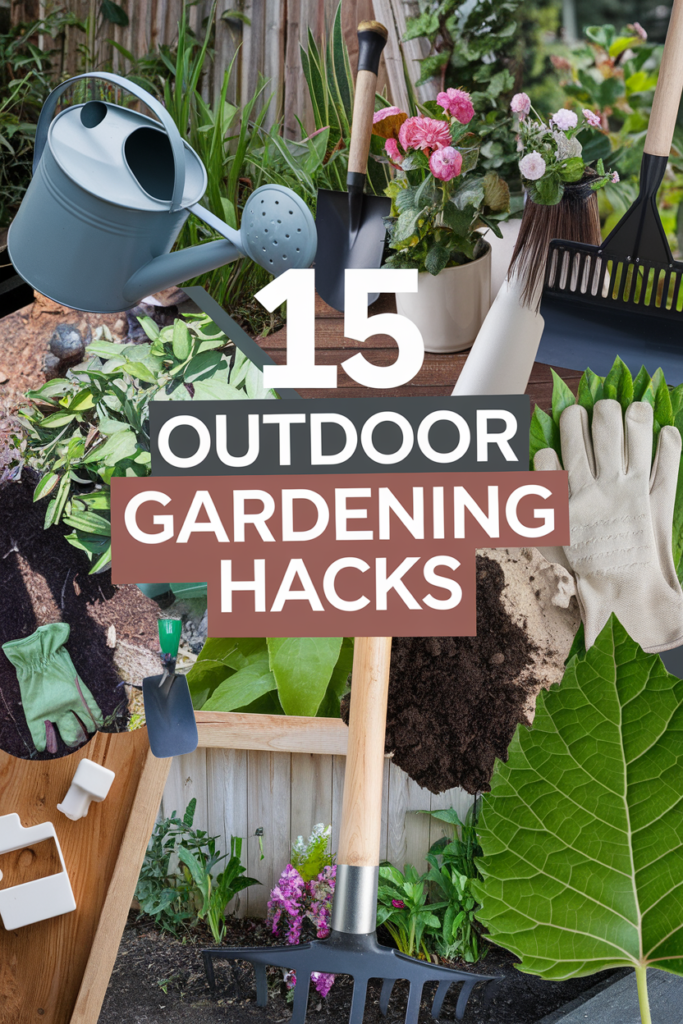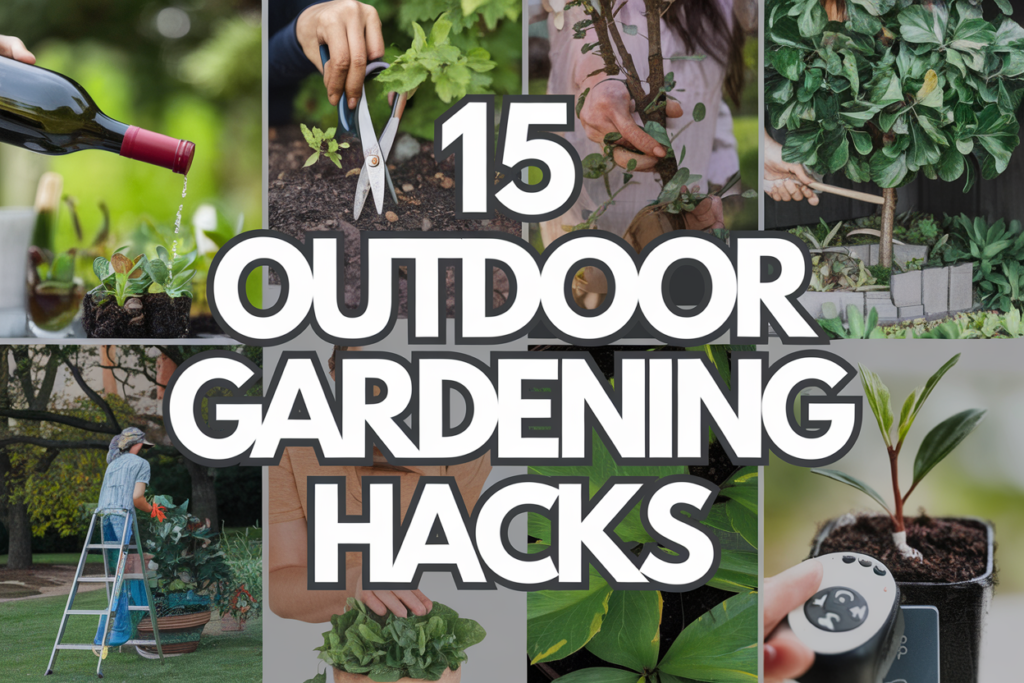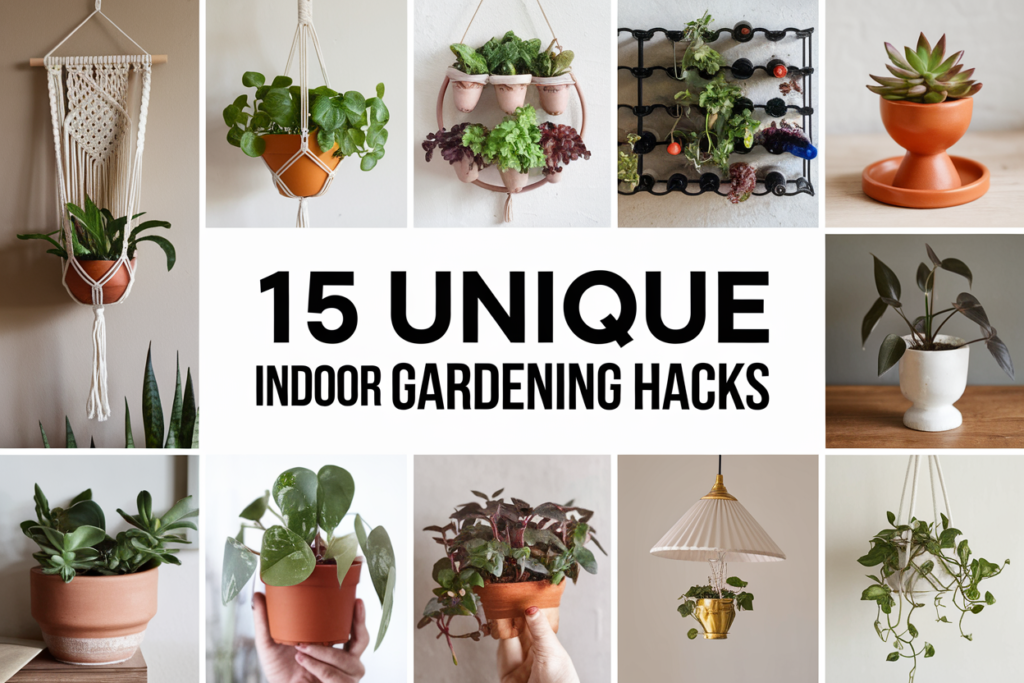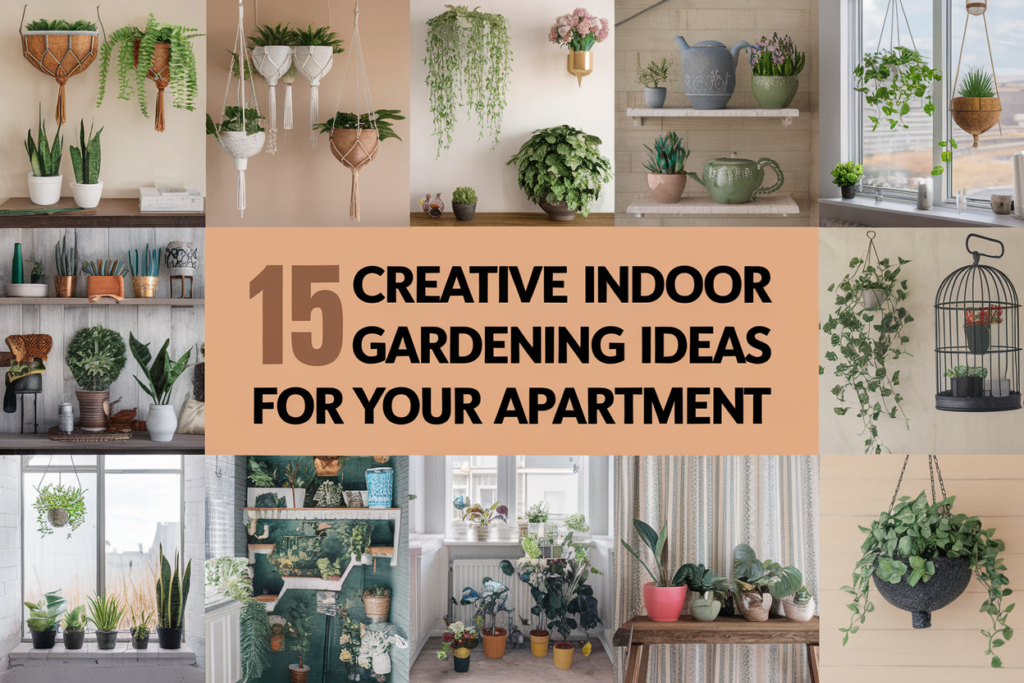Gardening can sometimes feel overwhelming, but it doesn’t have to be! With these 15 outdoor gardening hacks, you’ll find simple and clever tips that make growing your plants a breeze. Whether you’re a seasoned pro or just starting out, these hacks will help you cultivate a thriving garden and enjoy the process even more.
Use Eggshells To Deter Slugs And Snails In Garden Beds.
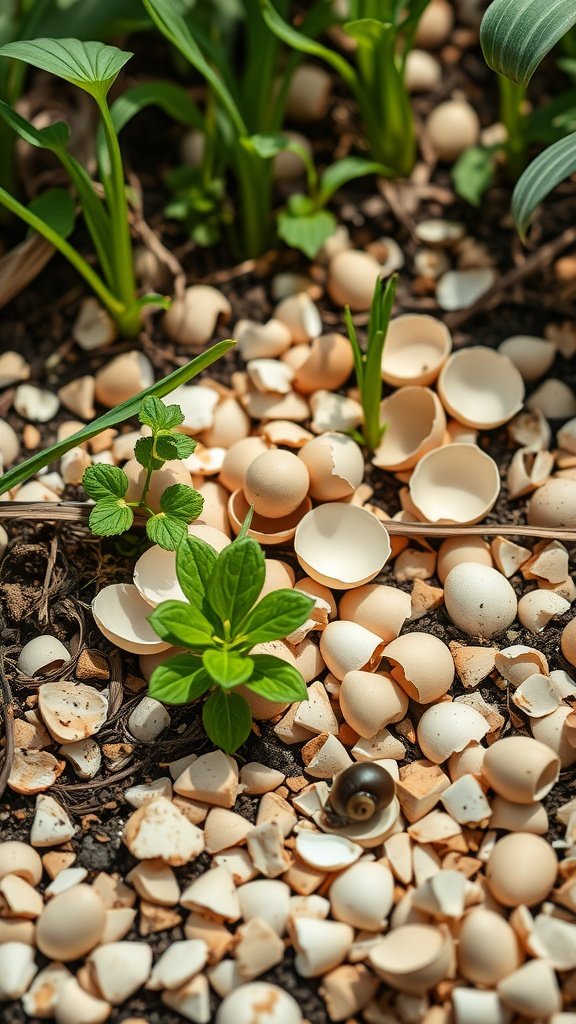
If you’ve ever found your plants chewed up by slugs and snails, you’ll love this simple hack. Eggshells can be a great natural deterrent for these slimy pests. The sharp edges of crushed eggshells create a barrier that slugs and snails don’t want to cross.
The image shows a garden bed with scattered eggshells, mixed in with healthy green plants. The sight of broken eggshells on soil not only looks rustic but also signals that you’re ready to protect your plants. The combination of eggshells and green foliage can create a vibrant, lively garden space.
To use this hack, rinse the eggshells and let them dry. Once they’re ready, crush them into small pieces. Spread the crushed shells around your plants, forming a protective ring. This will not only deter the pests but also add some nutrients back into the soil as the shells break down over time.
Install Rain Barrels To Collect Free Water For Your Plants.
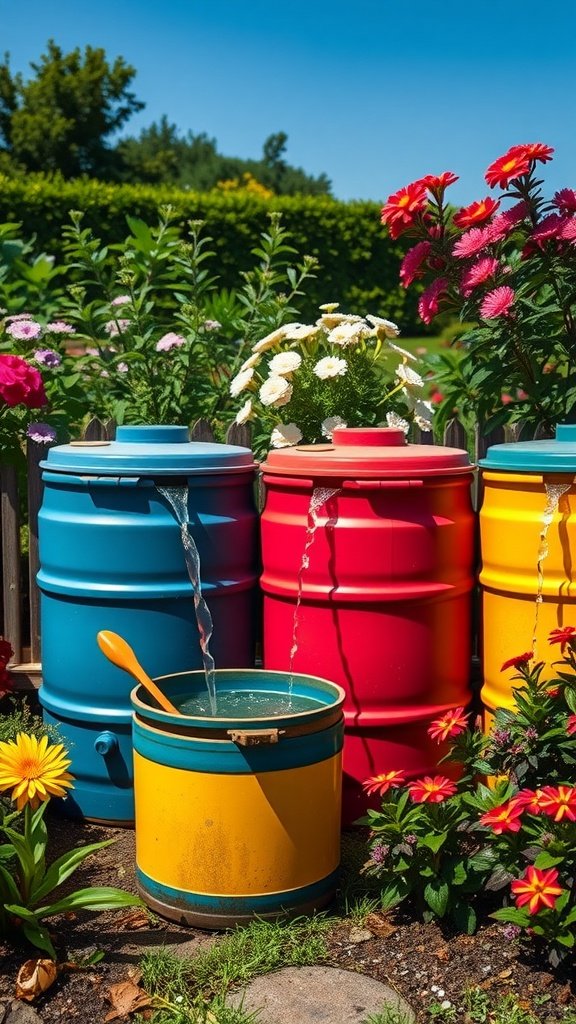
Installing rain barrels is a fun and easy way to collect free water for your garden. The image shows colorful barrels set up to catch rainwater, creating a vibrant addition to any outdoor space. The blue, red, and yellow barrels stand out against a backdrop of bright flowers, making them both functional and decorative.
Rainwater is soft and free from chemicals, making it perfect for your plants. By collecting rainwater, you can save money on your water bill and help the environment. Plus, it’s a great way to ensure your plants get the best possible hydration.
To get started, place your barrels under your gutters or any area where rainwater flows. Make sure they have a lid to keep debris out and a spout to easily fill your watering can or hose. This setup not only conserves water but also adds a splash of color to your garden!
Mulch With Grass Clippings To Retain Soil Moisture.
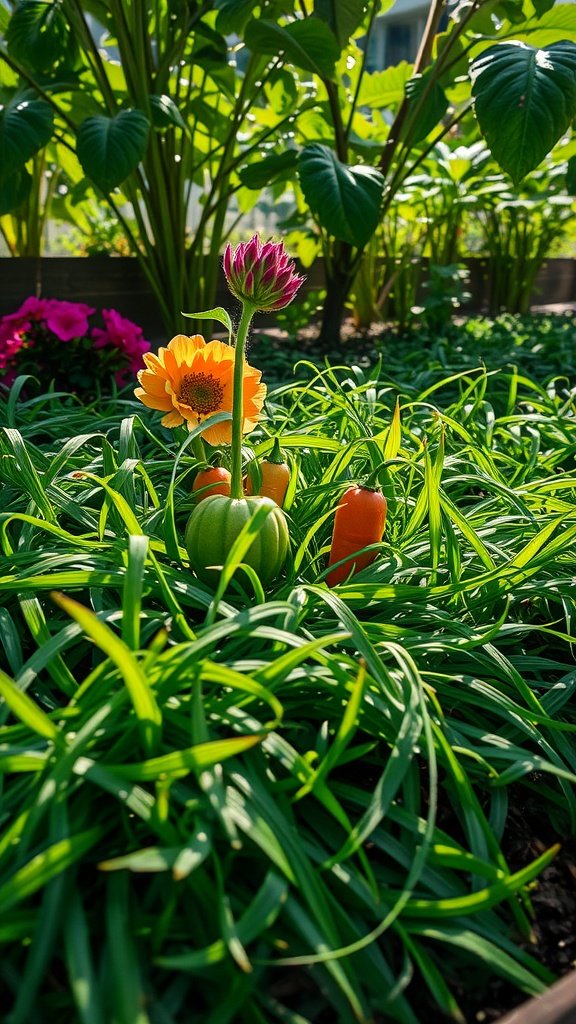
Using grass clippings as mulch is a simple and effective way to keep your garden thriving. The image shows a vibrant garden scene, with colorful flowers peeking through a lush bed of grass. This visual highlights the benefits of mulching, where clippings provide both beauty and functionality.
Grass clippings help retain moisture in the soil, reducing the need for frequent watering. When spread around plants, they create a barrier that keeps the soil cool and damp. This is especially handy during hot summer months when water evaporates quickly.
To use grass clippings as mulch, simply collect the cuttings from your lawn mower. Let them dry for a bit before applying, as wet clippings can clump together and create a mat that prevents water from reaching the soil. Spread a layer of about two to three inches around your plants, making sure not to pile it against the stems.
This eco-friendly practice not only reduces waste but also feeds the soil as the clippings decompose. It’s a win-win for your garden and the environment!
Plant Marigolds To Naturally Repel Garden Pests.
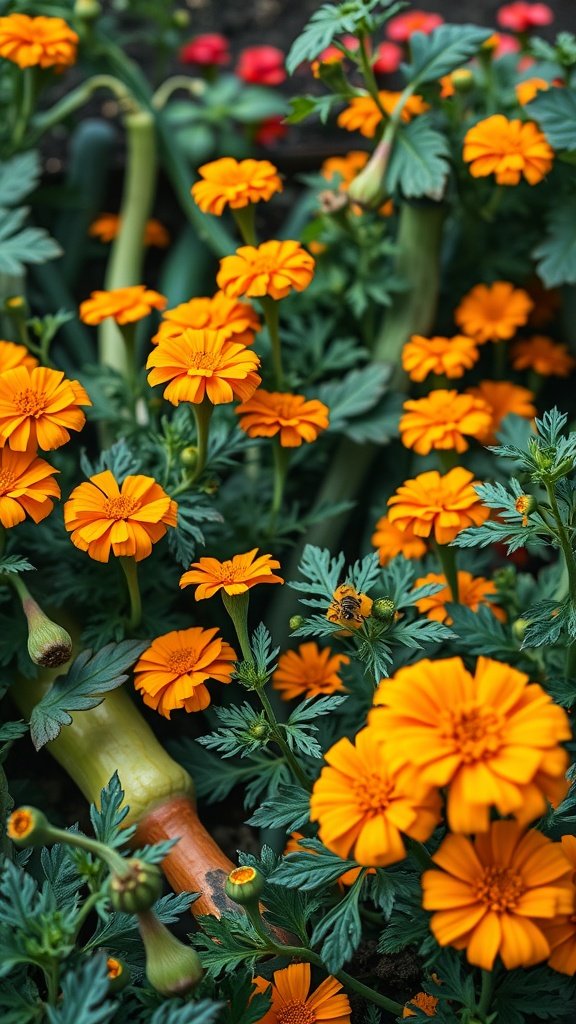
Marigolds are more than just pretty flowers. Their bright orange and yellow blooms add a splash of color to any garden. In the image, you can see a thriving patch of marigolds surrounded by lush green foliage. Their vibrant colors not only catch the eye but also play a vital role in pest control.
These flowers naturally repel a variety of garden pests, including aphids, nematodes, and whiteflies. By planting marigolds alongside your vegetable crops, you can create a protective barrier without using harsh chemicals. This simple gardening hack can lead to healthier plants and a more productive garden.
Plus, marigolds are easy to grow. They thrive in sunny spots and can handle a range of soil types. Just plant them in your garden, and watch them work their magic against pests. You’ll enjoy a more vibrant garden while keeping your plants safe.
Use Coffee Grounds To Improve Soil Acidity For Acid-Loving Plants.
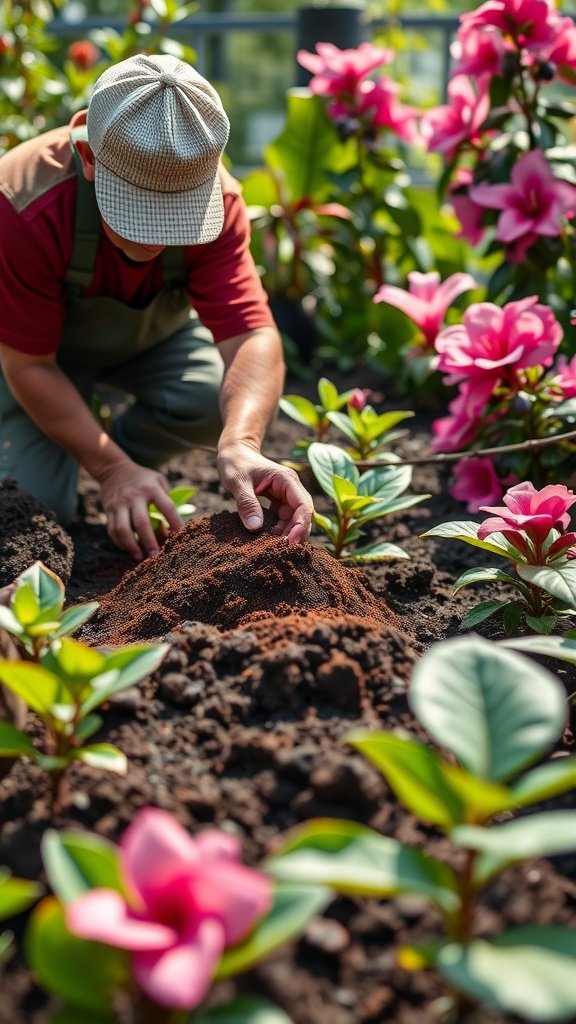
Coffee grounds are a simple and effective way to boost the soil for acid-loving plants. In the image, a gardener is applying coffee grounds around vibrant flowers, demonstrating a hands-on approach to gardening.
Acid-loving plants, like azaleas and blueberries, thrive in soil with a lower pH. Coffee grounds can help achieve this. As the grounds break down, they release nitrogen and other nutrients, enriching the soil.
To use coffee grounds, collect them after brewing your favorite cup. Make sure they are cool and dry before adding them to your garden. Simply sprinkle a thin layer around the base of your plants, mixing it into the soil lightly.
This method not only improves soil acidity but also helps retain moisture, providing a perfect environment for your plants to flourish. It’s an eco-friendly way to recycle your coffee waste while giving your garden a little boost.
Make A Diy Bird Feeder From Pinecones To Attract Helpful Birds.
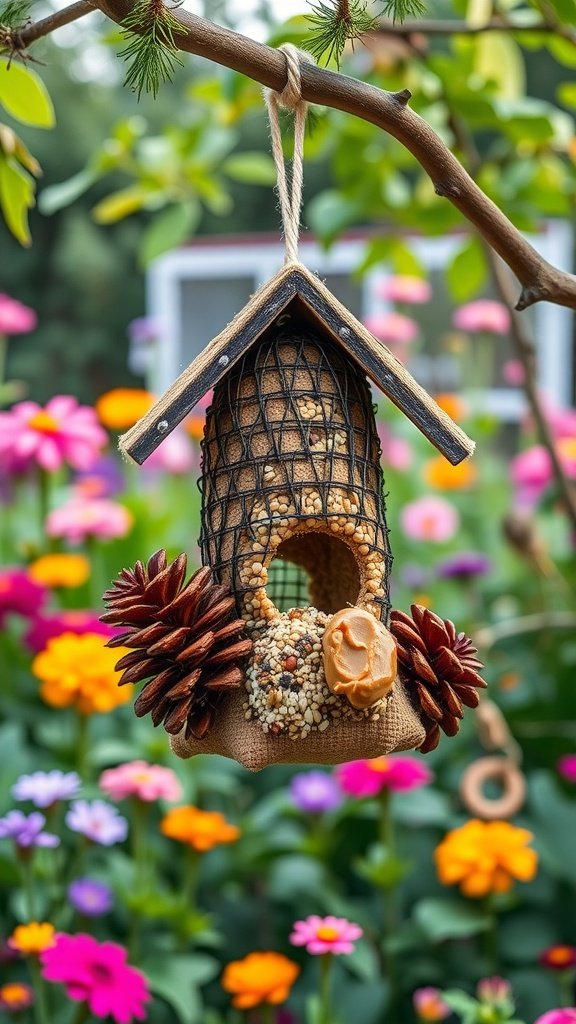
Creating a DIY bird feeder from pinecones is not only fun but also incredibly beneficial for your garden. The image shows a charming bird feeder made from a pinecone, complete with a burlap base and a sprinkle of seeds. This feeder is not just a treat for birds; it adds a rustic touch to your outdoor space.
To make your own, gather a few pinecones, some peanut butter, and birdseed. Start by spreading peanut butter all over the pinecone. Then, roll it in the birdseed until it’s well-coated. Tie a string around the top of the pinecone, and hang it from a tree branch. Birds will flock to your garden, helping with pest control and adding life to your landscape.
Install A Drip Irrigation System To Save Water And Reduce Weeds.
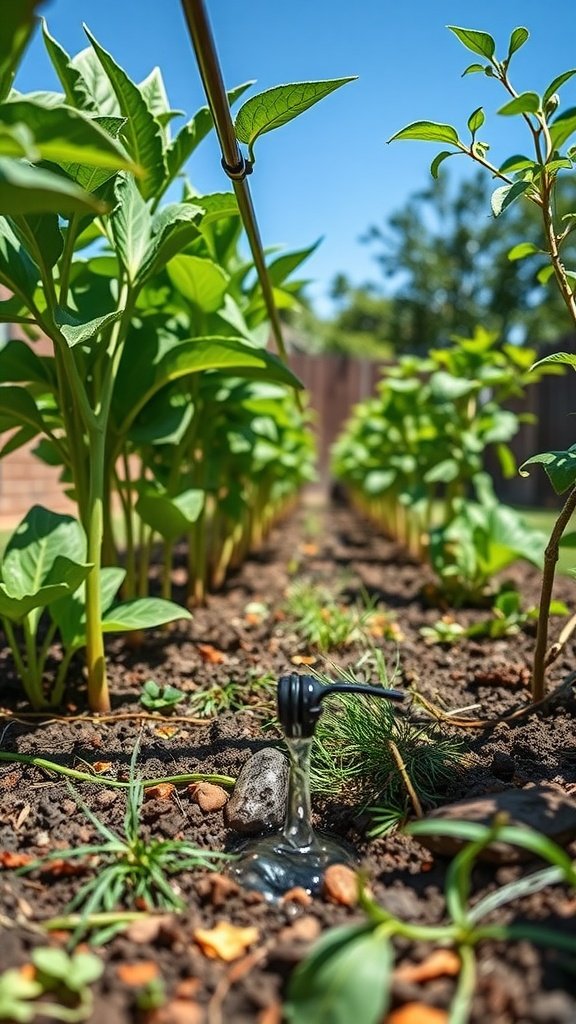
Picture this: you walk through your garden, greeted by healthy plants and minimal weeds. This can be your reality with a drip irrigation system. The image shows a simple setup where water gently seeps into the soil, nourishing the roots of nearby plants. This method not only saves water but also keeps the soil moist without oversaturating it.
Drip irrigation delivers water directly to the base of each plant. This targeted approach helps reduce waste while ensuring each plant gets the hydration it needs. By minimizing water on the surface, you also limit weed growth. Weeds thrive in moist, exposed soil, so keeping water at the roots can make a big difference in your garden’s health.
Installing a drip system is straightforward. You can find kits at garden centers that include everything you need. Once it’s set up, you can even attach a timer, so your plants get watered automatically. This saves you time and helps maintain a consistent watering schedule. Plus, it gives you peace of mind, knowing your garden is getting the care it deserves.
Reuse Old Pots For Creating Vertical Plant Gardens.
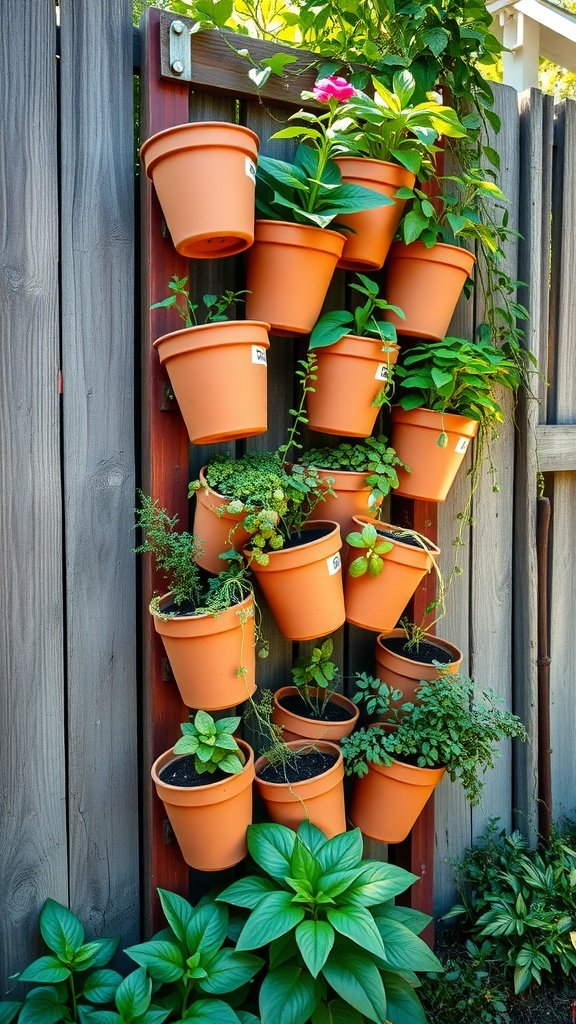
Transforming your garden with vertical plant arrangements is a fun way to reuse old pots. The image shows a striking display of terracotta pots mounted on a wooden frame. Each pot brims with vibrant greenery, showcasing an attractive and space-saving design.
Vertical gardens are perfect for small spaces. They allow you to enjoy your plants without taking up much ground area. The height adds visual interest, making your garden feel more dynamic. Using old pots not only saves money but also gives your garden a personal touch.
To create your vertical garden, start by gathering your old pots and choosing a sturdy wall or frame to mount them on. Arrange the pots in a way that complements your space. You can plant a mix of herbs, flowers, and leafy greens to create a colorful display.
Don’t forget to consider drainage. Ensure there are holes in the pots, or use a liner to prevent water buildup. This will keep your plants healthy and thriving. With a little creativity, your old pots can flourish in a whole new way!
Protect Young Plants With Cloches Made From Plastic Bottles.
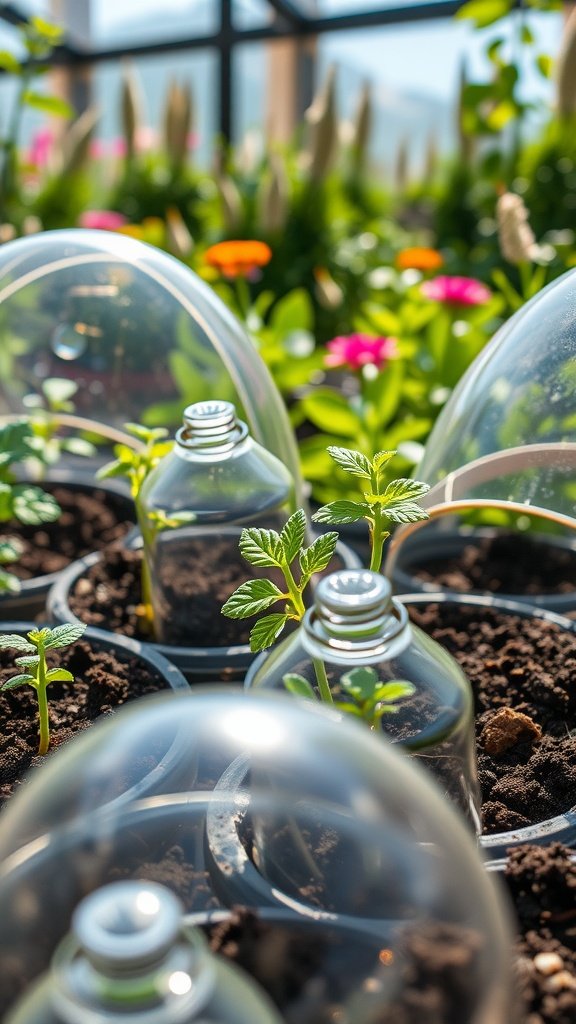
In the garden, young plants need a little extra care to thrive, especially when the weather can be unpredictable. Using plastic bottles as cloches is a clever and eco-friendly hack. This image shows a vibrant garden scene where tender seedlings peek out from their plastic bottle covers, offering protection from harsh elements.
These makeshift greenhouses create a warm and humid environment, ideal for helping young plants grow. Simply cut the bottom off a plastic bottle and place it over each seedling. The clear plastic allows sunlight to filter through while keeping out pests and providing shelter from chilly winds.
This hack is not only practical but also reduces waste. Instead of tossing out those empty bottles, give them a new life in your garden. You’ll find that your seedlings flourish under their little protective domes, helping you boost your green thumb effortlessly!
Use A Compost Pile To Enrich Your Garden’S Soil.
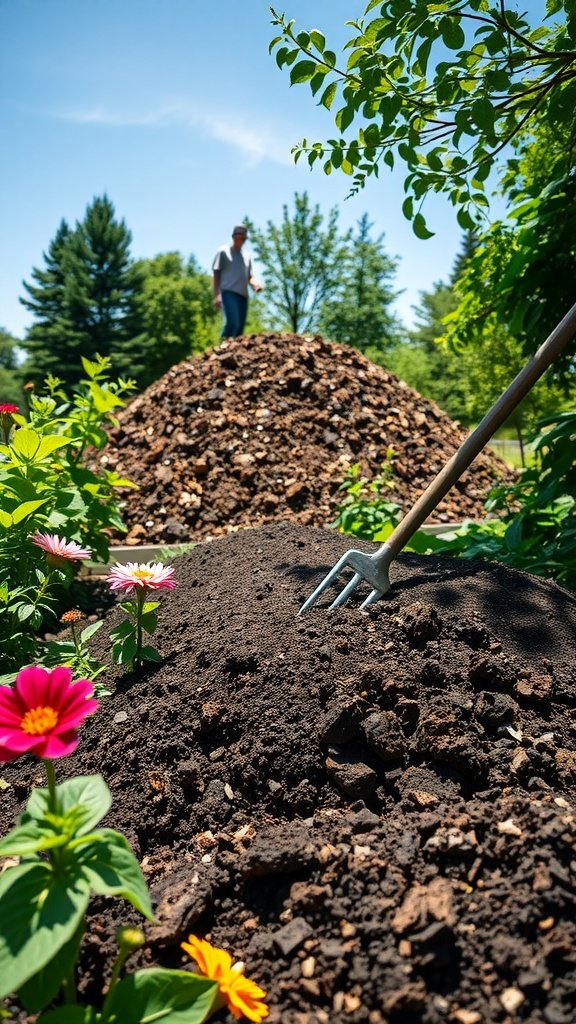
Creating a compost pile is one of the simplest and most rewarding ways to boost your garden’s soil. The image shows a well-structured compost mound, with a gardener standing nearby. This pile is not just a heap of scraps; it’s a treasure trove of nutrients waiting to enrich your plants.
Composting involves collecting organic materials like kitchen scraps, yard waste, and even paper products. Over time, these materials break down and transform into dark, crumbly compost. This nutrient-rich addition helps improve soil structure and enhances water retention, making it easier for your plants to thrive.
The vibrant flowers in the foreground highlight the difference that good soil can make. By using compost, you’re not only feeding your plants but also supporting beneficial microorganisms in the soil. These tiny helpers break down nutrients and make them accessible to your plants.
On sunny days like the one captured in the image, taking care of your compost pile can become a simple yet satisfying task. Regular turning of the pile ensures proper aeration, speeding up the decomposition process. Plus, it’s a great way to get outside and enjoy your garden!
Create A Diy Pest Repellent Using Garlic And Chili Sprays.
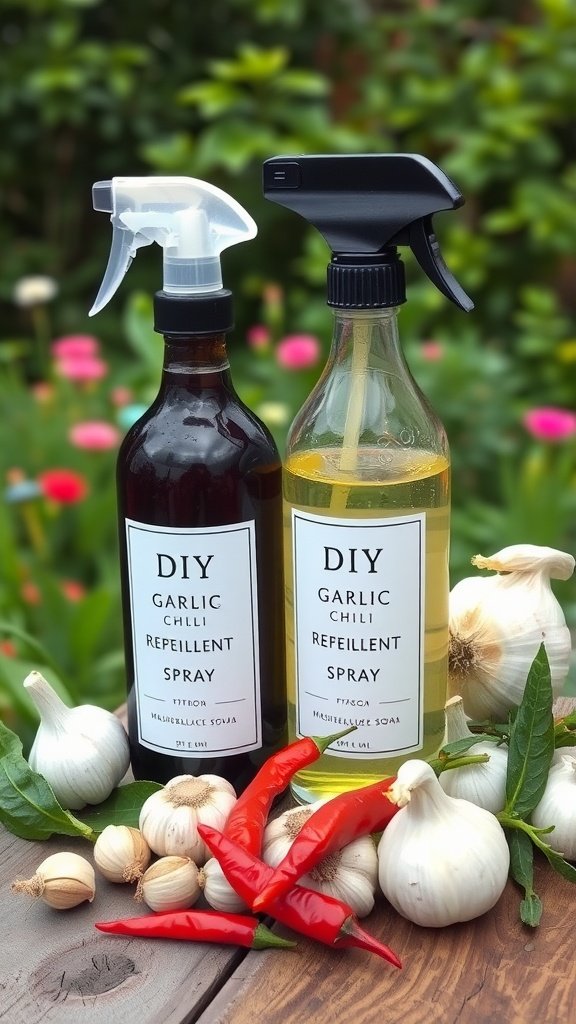
If you’re looking for a natural way to keep pests away from your garden, garlic and chili sprays are fantastic solutions. The image shows two bottles of garlic sprays, surrounded by fresh garlic and vibrant red chilies. This setup not only looks appealing but also represents an effective pest control method.
Garlic is known for its strong scent, which many pests find unpleasant. Combine that with the heat from chili peppers, and you have a powerful repellent. Making this spray is simple and can be done with just a few ingredients.
To create your DIY pest repellent, gather your ingredients: fresh garlic, chili peppers, water, and a spray bottle. Start by blending a few cloves of garlic and some chopped chili peppers with water. Allow the mixture to sit for a day, then strain it into a spray bottle. You can now use this potent spray to protect your plants from unwanted visitors.
Repurpose Kitchen Scraps As Natural Plant Fertilizers.
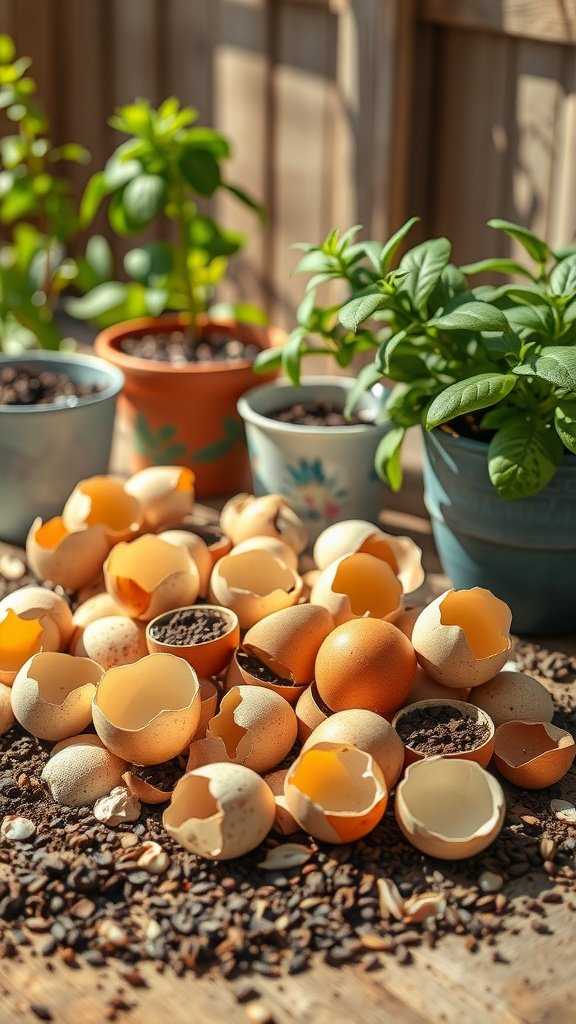
Using kitchen scraps as plant fertilizers is a simple and effective way to nourish your garden. The image shows a collection of eggshells scattered around some potted plants. These eggshells are rich in calcium, a vital nutrient for plant growth.
Instead of throwing away your eggshells, rinse them and let them dry. You can crush them into small pieces and sprinkle them on top of the soil. This method not only adds nutrients but also helps improve soil texture.
Incorporating other kitchen scraps like fruit peels and coffee grounds can boost your garden’s health. These scraps decompose over time, enriching the soil with organic matter. You might be surprised at how much your plants can thrive using what you already have at home!
Create Natural Garden Markers From Stones Or Wooden Sticks.

Using natural materials for garden markers adds charm to your outdoor space. The image showcases vibrant flowers surrounded by smooth stones and wooden sticks. The colorful blooms create a lovely backdrop, highlighting the rustic markers that stand proudly among them.
Making your own markers is simple and fun. You can use small wooden sticks or stones to label your plants. Just grab a few clean pieces from your garden or a craft store. For stones, paint the names of your herbs or flowers directly on them. For wooden sticks, use a permanent marker or paint to write the names. This way, you’ll easily identify what you’ve planted.
Not only do these markers help you keep track of your plants, but they also add a touch of personality to your garden. They can blend beautifully with the natural elements around them, just like in the picture. Plus, you can get creative with colors and designs to match your garden’s vibe!
Companion Plant To Boost Growth And Reduce Pest Issues.
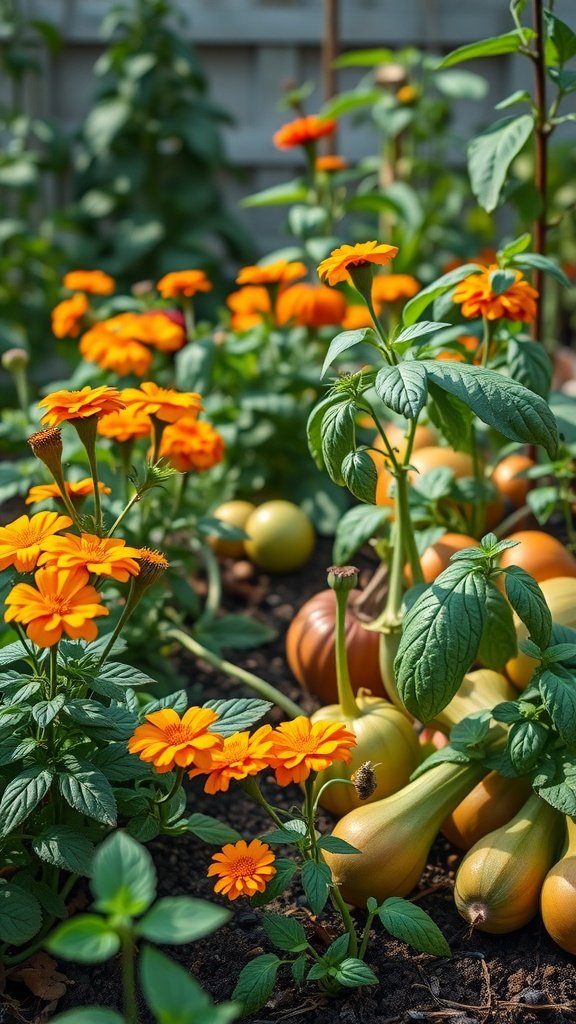
Check out this vibrant garden scene! Here, we see a mix of bright orange flowers and lush green vegetables thriving side by side. Companion planting is a fantastic way to help your plants grow better and deal with pests naturally.
The beautiful marigolds in the foreground are known for their ability to deter pests like nematodes and aphids. When planted alongside vegetables, they can reduce the need for chemical pesticides, making your garden healthier and more eco-friendly.
Not only do these flowers add a pop of color, but they also attract beneficial insects. Ladybugs and lacewings, for example, love to hang around marigolds. These helpful bugs feast on harmful pests, giving your vegetables a better chance to flourish.
In this garden setup, we can see squash and tomatoes nestled among the marigolds. This combination works wonders as they support each other’s growth. The marigolds help repel pests while the veggies provide a rich environment for the flowers.
Recycle Plastic Bags Into Garden Plant Ties Or Trellises.
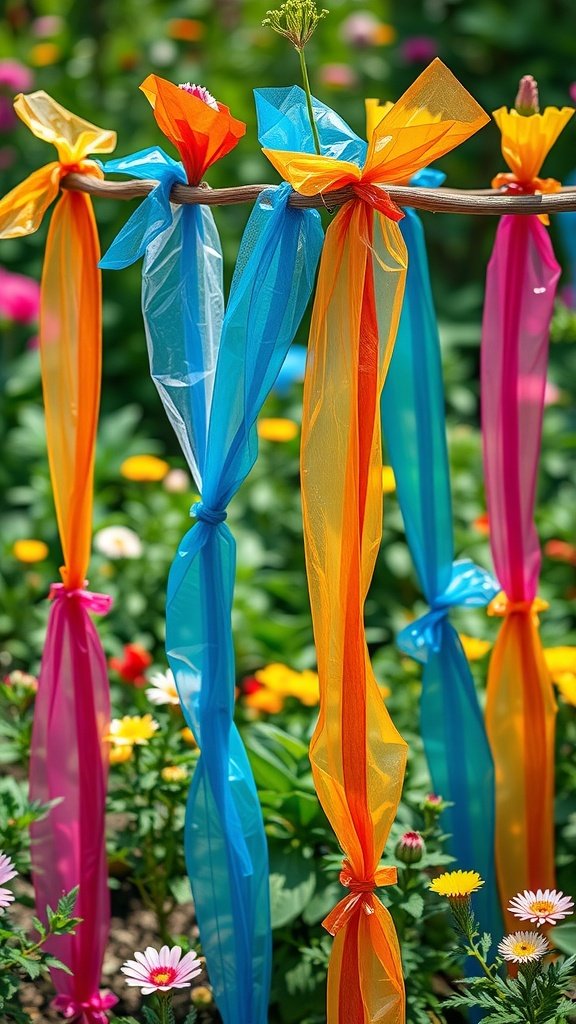
Turning old plastic bags into garden ties or trellises is a clever way to recycle while adding color and support to your plants.
The image showcases bright, colorful ties made from plastic bags, adding a playful touch to a garden filled with vibrant flowers. These ties can help your plants grow upright and stay healthy.
To create your own plant ties, simply cut plastic bags into strips. You can tie them around branches or stakes, providing the support your plants need. It’s an easy project that saves money and reduces waste.
Plus, using colorful bags not only supports your plants but also brightens up your garden. This simple hack enhances your gardening experience while being eco-friendly. Next time you have a plastic bag to toss, think twice and give your plants a boost instead!
